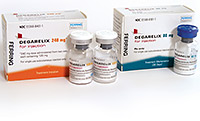Degarelix to treat advanced prostate cancer
COMPANY: Ferring
PHARMACOLOGIC CLASS: GnRH receptor antagonist
ACTIVE INGREDIENT: Degarelix 80mg/vial, 120mg/vial; pwd for SC inj after reconstitution.
INDICATION: Advanced prostate cancer.
PHARMACOLOGY: Degarelix binds reversibly to pituitary gonadotropin releasing factor (GnRH) receptors, causing a decrease in the release of gonadotropins and in the production of testosterone. It is effective in maintaining the suppression of testosterone below the medical castration level of 50ng/dL. Upon subcutaneous injection, this product forms a depot from which degarelix is released to the systemic circulation. It is metabolized by peptide hydrolysis in the hepatobiliary system and is eliminated as peptide fragments in the feces.
CLINICAL TRIALS: A one-year study was conducted to compare degarelix to leuprolide in the treatment of 620 patients with prostate cancer. The primary objective was to demonstrate that degarelix effectively lowered and maintained testosterone levels to castration levels of ≤50ng/dL over 12 months. Serum testosterone levels were measured at screening, and on days 0,1,3,7,14, and 28 in the first month, then monthly until the end of the study. The median serum testosterone levels across all treatment arms was 400ng/dL. The patients given degarelix were divided into two groups: after an initial dose of 240mg SC, they were given either 160mg or 80mg SC once every 28 days. The patients treated with leuprolide were given 7.5mg IM once monthly. Of the group given degarelix 160mg monthly, 98.3% achieved medical castration (serum testosterone ≤50ng/dL) from day 28 to day 364, compared to 97.2% for the degarelix 80mg/month group. The group given leuprolide had a rate of 96.4%. The suppression of testosterone levels ≤50ng/dL occurred significantly faster in patients receiving degarelix than in those receiving leuprolide. By day 3, 96% of the patients given degarelix attained serum testosterone levels at or below 50ng/dL, compared to 0% for those given leuprolide. By day 7, 99% of the degarelix-treated patients were at the medical castration level, compared to 1% for the leuprolide group. At day 28, all groups were at or above 99%. A secondary endpoint, PSA level, was monitored as well. Serum PSA levels were lowered by 64% 2 weeks after the administration of degarelix, 85% after 1 month, and 95% after 3 months, and remained suppressed for the remainder of the year of treatment.
ADULTS: Give by SC inj in abdomen once every 28 days; avoid waist and rib areas. Two 120mg injections once, then one 80mg inj once every 28 days.
CHILDREN: Not recommended.
CONTRAINDICATIONS: Pregnancy (Cat.X).
PRECAUTIONS: Severe renal or hepatic impairment. Congenital long QT syndrome. Electrolyte imbalances. Congestive heart failure. Monitor serum PSA. Nursing mothers: not recommended.
INTERACTIONS: Caution with Class IA (eg, quinidine, procainamide) or Class III (eg, amiodarone, sotalol) antiarrhythmics.
ADVERSE REACTIONS: Inj site reactions (eg, pain, erythema, swelling, induration), hot flashes, increased weight, fatigue, increased transaminases, increased gamma-glutamyl transferase; QT prolongation.
HOW SUPPLIED: Treatment Initiation pack (120mg/vial)—2 (w. supplies) Treatment Maintenance pack (80mg/vial)—1 (w. supplies)
For more information call (888) FERRING or visit www.Degarelix.com.
